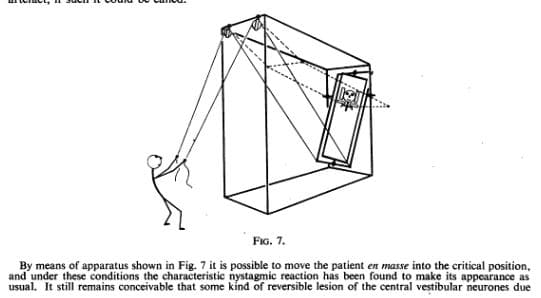 Paving the way isn’t always easy.
Paving the way isn’t always easy.
Today’s post started as a Thanksgiving-themed “Thank you” note to some of our vestibular pioneers, but as I researched the backgrounds of these pioneers, I was struck by some of the trials, tribulations, and misadventures some of them encountered.
Let’s start with Robert Barany. He won the Nobel Prize for Physiology or Medicine in 1914, and is responsible for, among other things, discovering that introducing different temperatures of water to the ear canal triggers nystagmus. He also described BPPV as early as 1921. Ironically, the patient he reported on was his medical assistant, Dr. Carlefors. Dr. Barany spent a few years in a Russian prisoner of war camp following World War I. Early in his career, Barany was basically run out of town, accused of plagiarism by colleagues.
The Dix Hallpike test, which is done many times daily in many clinics throughout the world, is named after two British otologists, M R Dix and C S Hallpike. They were the first to apply the label of Benign Paroxysmal Positional Vertigo (BPPV) and concluded that it was likely the result of utricular dysfunction. They did not speculate or consider the concept of free floating debris in the semi-circular canal. Interestingly, during their research they speculated that neck torsion may have been a contributor and designed a contraption to tilt the patients head back without neck torsion. See the picture below, and give thanks that the standard Dix-Hallpike as we know it does not require ropes and pullies.
Another interesting and disturbing tidbit about M R Dix and C S Hallpike is that one of their earlier joint efforts resulted in an article titled: The PeepShow: A New Technique For Pure-Tone Audiometry In Young Children
John Epley is largely responsible for developing and popularizing the Canalth Repositioning Procedure (CRP). The Epley maneuver is so simple and effective that most patients are aware of it or have tried a home version of it before they come in to the office. I have even heard it used as a verb, “They Epleyed me.”
Going back to review Epleys earliest publications reveals that he was as mystified by BPPV as was everyone else in the early part of his career. Epley’s first publication related to BPPV in 1979 proposed that the symptoms were most likely related to cupulolithiasis of the posterior canal, and reports on nine patients whose symptoms were resolved after singular neurectomy. He obviously changed his approach somewhere between 1979 and 1992 when his first paper on canalith repositioning came out.
Epley took a lot of heat for proposing and advocating for such a radical approach to a common problem. The article Cursing the Cure – Doctor and Invention Outlast Jeers and Threats describes the trials (literally) and tribulations John Epley endured along the way.
Personal note:
In the early 90’s, I attended one of the first courses where Epley described canalith repositioning. I recall a lot of skepticism in the audience. I made a point to sit with him at lunch that day and walked away convinced he was a reasonable and sincere person. When I got back to my practice and saw how effective the CRP was, I started talking it up to local PCP’s and ENT specialists. I also got a small dose of that skepticism from some of them, detailed in my old post Vestibular Smackdown.







